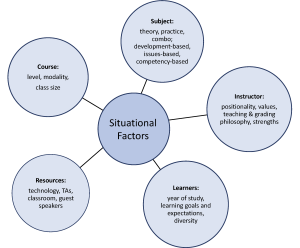Context
Situational Factors to Consider

Image 1. Examples of Situational Factors Influencing Teaching/Learning
Reflect on the questions below to help guide the (re)design of your course.
- How many students are in the class?
- Is this an undergraduate course? Graduate course? Required or not?
- How long and frequent are the class meetings?
- How will the course be delivered? In-person, online, lab, field? Hybrid, multi-access?
- What physical elements of the learning environment will affect the class?
- What learning expectations are placed on this course or curriculum by: the university? Department? Profession? Society?
- What technology will you need to use for instructional modality and to support learning?
- How will the physical learning space serve teaching/learning?
- Will you have Teaching Assistants? For instructional support? For grading?
- Will you have guest speakers?
- Is the subject primarily theoretical, practical or a combination of both?
- Will the subject be organized in a way that is development-base, issues-based, or competency-based learning?
- Are there important changes or controversies occurring within the field?
- Does your course relate to other courses in the dept? at UBCO?
- What is the year of study of learners? Same year? Mixed?
- What is the life situation of the learners (working, family, professional goals)?
- What prior knowledge, experiences and initial feelings do students usually have about this subject?
- What are their learning goals, expectations?
- How will the diversity of your students impact how you teach? EDI (equity, diversity & inclusion)
(Your values and strengths will guide selection of content, strategies and assessment.)
- What beliefs and values do you have about teaching and learning?
- What is your attitude toward: the subject? students?
- What level of knowledge or familiarity do you have with this subject?
- What are your strengths in teaching?
- What is your teaching philosophy? grading philosophy?
- What are your goals and purposes in teaching this course?
Reference:
Tessmer, M., & Richey, R. (1997). The Role of Context in Learning and Instructional Design. Educational Technology Research and Development, 45(2), 85-115.
After identifying the factors that are likely to have the most impact on design of a particular course, a helpful next step is to consider how the relationship among them can best support learner experiences. For example, useful questions to ask include:
- What background knowledge do learners have to connect with the subject? What instructional strategies could help learners access their existing knowledge and experiences?
- What personal experiences does the instructor have to highlight the relevance of the subject? In what ways could those be shared with learners?
- How can technology be leveraged to help learners unpack and make connections among concepts?
- How can the size of the class and diversity among learners be used in benefit of exploration of the subject?
Reflecting on such questions helps to centre design choices around what learners already know, are curious about, and hope to understand and be able to do. In addition, providing context and real-world connections to the subject motivates learners, increases their interest and confidence, and enhances long-term goals.
“Contextualizing instruction makes abstract concepts more concrete, promotes understanding and retention.” (Tessmer & Richey, 1997)